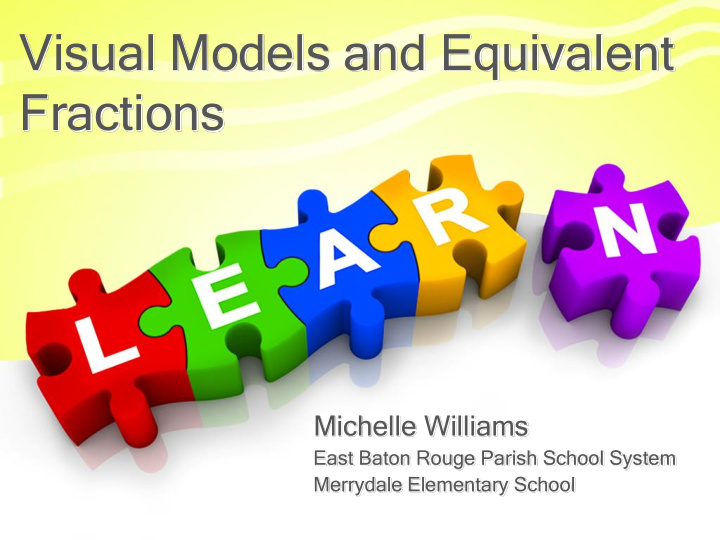



Visual Models and Equivalent Fractions Michelle Williams East Baton Rouge Parish School System Merrydale Elementary School
Agenda • What is conceptual understanding?(10 minutes) • Creating equivalent fractions (5 minutes) • Generating equivalent fractions-fraction Wheels (20 minutes) • Simplifying fractions-color tiles/pattern blocks (20 minutes) • Division and multiplication- area model (20 minutes) • Closure- Answer/discuss the essential question (5 minutes)
Session Objectives • Participants will be able to create equivalent fractions using color tiles, fraction wheels, area models and pattern blocks • Participants will be able to determine if an equivalent fraction has been created through multiplication or division
Essential Question Why is conceptual understanding of mathematical concepts important for elementary students?
Equivalent Fractions Vertical Alignment 3 rd -5 th 3 rd rd Grade de - a. Understand two fractions as equal if they are the same size or the same point of the number line. e.g., 1/2 = 2/4, 4/6 = 2/3 b. Recognize and generate simple equivalent fractions. Explain why the fractions are equivalent. e.g., visual model 4 th th Grade de - a. Explain why a fraction a/b is equivalent to a fraction ( n x a)/( n x b) by using visual fraction models with attention to how the number and size of parts differ even thought the two fractions themselves are the same size. Use this principle recognize and generate equivalent fractions. 5 th th Grade de - a. Add and subtract fractions with unlike denominators (including mixed numbers) by replacing given fractions with equivalent fractions in such a way as to produce an equivalent sum or difference of fractions with like denominators
Mathematical Practices • Model with mathematics • Use appropriate tools strategically • Look for and make use of structure • Look for and express regularity in repeated reasoning
What is Conceptual Understanding? • Comprehension of mathematical concepts, operations, and relations • Reflects a student's ability to reason in settings involving the careful application of concept definitions, relations, or representations of either.
What Does it Mean to be Mathematically Proficient? • Conceptual understanding • Procedural fluency • Strategic competence • Adaptive reasoning • Productive disposition
How Are Equivalent Fractions Created? • Multiplication- numerator and denominator increases numerically and the fraction decreases • Division- numerator and denominator decrease and the fraction increases
F Generating Equivalent Fractions R Using Fraction Wheels A C T I O N 4 th Grade Class W H E E L S 5.NF.1
Equivalent Fractions, Simplest Form, and Color Tiles C O L O R T 4 th Grade Class I L E S 5.NF.1
p Pattern Blocks and Simplest A Form T T E Putting fractions in R simplest form means N using the largest amount to create an B 4 th Grade Class equivalent fraction or L O the smallest C number for the K denominator S 5.NF.1
Putting it All Together Area Model A R E A M 4 th Grade Class O D E L 5.NF.1
Resources • www.learnzillion.com • www.aimsedu.org • www.youtube.com/user/FractionBars • www.fuelgreatminds.com/blog
Contact Information Michelle Williams mwilliams@fuelgreatminds.com mwilliams11@ebrschools.org
Recommend
More recommend